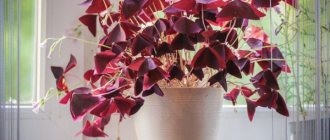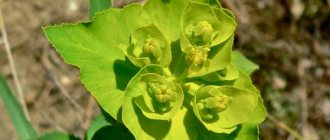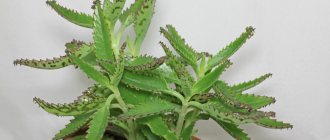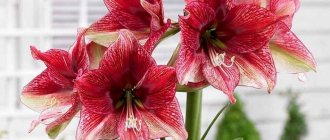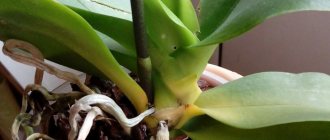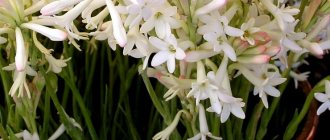To successfully grow each of them, it is enough to adhere to simple requirements:
- observe periods of rest, creating cool conditions;
- provide the flowerpot with high humidity;
- choose a porous substrate for good aeration of the root system.
The genus of this family belongs to epiphytes, which often use other crops as support. However, they feed on their own.
Their main feature is their unquenchable thirst for moisture. Therefore, before you buy a luxurious exhibit, you should think about the possibility of creating favorable conditions for its wild prosperity. See: types of orchids - photos and names.
Distinctive characteristics
Distinctive features of the Tselogina orchid, which belongs to the sympodial orchids:
- Short roots.
- Pseudobulbs are round in shape, about 5 cm in size. They produce one peduncle and a pair of leaves.
- The leaves are linear, with a glossy tint, dark green, cut with a fold. About 30 cm long.
- Flowers are up to 10 cm in diameter, have five petals, and a wide lower lip. They come in white, light yellow, light green and cream colors, often with patches of purple.
Coelogina flowering
In late autumn or winter, the celogina produces its peduncle. It is drooping, 20-60 cm long. Closer to the top, a brush of 5-17 corollas is formed. The lip is open, three-lobed. It is surrounded by 5 lanceolate curly petals, their shade, in addition to snow-white, is cream or light yellow. Short, ridge-like growths of a darker tone form at the base of the lip. The corollas are relatively small, but form a lush inflorescence and have a delicate aroma. They wilt by mid-March.
Popular types: photos and descriptions
Cristata or comb (Cristata)
The pseudobulbs are round, the leaves are belt-like. The length of the peduncle is 30 cm. From 3 to 10 flowers are formed on it. The flowers are up to 8 cm in diameter, white, the three-lobed lip is orange-yellow.
In order for Kristata to delight with her flowering at home, she needs some care.
She prefers shady places with diffused light, high air humidity and good air exchange around the root system.
Fimbriata or fringed (Fimbriata)
Slightly flattened pseudobulbs are only about 3 cm in size. They are bifoliate, ovoid or elliptical in shape. Leaves are linear. The peduncle reaches a length of 5 cm, and the size of the flowers is 3 cm. The lip is triple and covered with fringe. The petals have a light-yellow tint, and the lip is decorated with cherry-colored patterns.
Asperata
The shape of closely spaced pseudobulbs is oval. Each peduncle produces 35 flowers. The flowers are large, 6.5-7.5 cm in size, with light green narrow petals and brown spots on the lip.
Rochusseni
Pseudobulbs are cylindrical in shape and produce two oval, pointed leaves. The flowers are lemon yellow. They emit a citrus aroma. The difference between the flowers is in the narrow-lanceolate and pointed sepals and petals. The lower lip of the flower is three-lobed.
Speciosa or beautiful (Speciosa)
The leaves are oblong, light green in color. The peduncles are short, with 1–2 buds appearing on them. The flowers are yellowish-green in color, have a wide lower lip, decorated with a yellow spot with red-brown streaks.
Flassida or drooping (Flaccida)
A plant with elongated pseudobulbs, long and drooping flower stalks. The leaves are bright green, lanceolate in shape. The lower lip of the flower is three-ridged and covered with bright yellow spots.
Ovalis or oval (Ovalis)
They are distinguished by their spindle-shaped pseudobulbs. Leaves are rich green. The color of the flowers is yellow-green. Brown veins are visible on the lower lip.
Miniata
Blooms in winter. Each peduncle bears four buds 2.5 cm wide. The color is beige or bright orange. Canine bulbs are brown in color and ovoid in shape.
Miniata is quite capricious in care and in order for new flower stalks to appear, it is necessary to create certain conditions for the plant.
Bearded (Barbata)
The shape of the bulbs is almost round, the color is light green. They are distinguished by elongated lanceolate leaves. The sepals and petals of the flower are elongated and white. The lower lip is greyish-brown and decorated with fringe.
Massangeana
Large bulbs. Veins stand out on long leaves. About 20 cream-colored flowers are formed on the flower-bearing arrow. The lower lip is three-lobed, ocher-colored, decorated with a yellow spot.
Mooreana
The height of an adult plant is about 40 cm. The pseudobulbs are ovoid in shape. Oval-lanceolate leaves with a glossy sheen. The flowers are snow-white. The edges of the petals are pointed. The lower lip is covered with a scattering of orange-golden spots.
Pandurata
The leaves are belt-shaped, with folds. The bulbs are oblong. The flowers are large, with creamy-green sepals. The wide lip is decorated with fringed combs and covered with spots of brown and black.
Usita (Usitana)
The bulbs are elongated. The light green leaves have noticeable veins. Each peduncle produces about 20 cream or greenish flowers. The lip is dark brown.
Christata
In the natural environment, representatives of the Christata (Comb) variety are found only in the high mountainous regions of the Himalayas, where they grow at the very edge of the snow cover. The orchid loves cold environments and has spherical-elongated pseudobulbs, 3 to 5 cm long. The plant also has 2 long leaves.
Peduncles are collected from 3-8 snow-white flowers with a diameter of about 10 centimeters. The flowers themselves are distinguished by their unusual lip structure. It consists of 3 blades and has 5 visible outgrowths - “combs”.
The flowering period begins in winter and lasts until early spring.
You can see what the Tselogina Christata variety looks like in the photo below:
Celogina Cristata
Home care
Temperature and ventilation
The temperature conditions are different, depending on the type of plant:
- hot (20–30 °C, with a difference in day and night temperatures of up to 2–3 °C);
- relatively cool (15–20 °C, with a difference of 5–7 °C);
- cool (15–20 °C, with a difference of up to 10 °C).
Throughout the warm period, celogina can be kept outdoors, but drafts should be avoided.
Lighting and location
Prefers diffused light; in winter it is necessary to use additional lighting. It should be remembered that direct sunlight harms the plant. The optimal location is window sills facing east or west.
Read here which artificial lighting to choose for a plant from autumn to spring.
Humidity and watering
Celogina needs a high level of humidity - 70–85%. It is recommended to install the plant in a tray filled with water.
Flowering and dormant period
It grows actively from early summer to early autumn. The end of September - beginning of October is a period of relative calm. Then the plant blooms until March, after which a dormant period of 15–20 days begins again.
Soil and planting capacity
The optimal soil should consist of well-seasoned pine bark, charcoal, decomposed sheet compost, sphagnum moss, perlite, expanded clay or polystyrene foam. The capacity depends on the type of orchid. These can be blocks made from pine bark, wide and low flower pots with drainage holes, plastic baskets with slits and holes.
The video shows how to make a substrate for celogina and which container is best to choose:
Fertilizers and fertilizing
Fertilize the plant with products designed specifically for orchid species. Feeding is carried out when the pseudobulbs begin their growth period.
During the resting stage, the orchid is not disturbed.
Transfer
Transplanting celogina is quite easy:
- Clean the plant from the remains of the old substrate, rotted and damaged roots.
- Activated carbon in powder form is applied to the cut areas and left to dry.
- Lower the root part into a container filled with drainage made of inert materials, cover it with substrate, slightly compacting it. Covered with moss.
Check out the video about the transplant rules:
Reproduction
Propagated by dividing the rhizome:
- Divide the rhizome of an adult plant, leaving 3–4 pseudobulbs on each separated part.
- Treat the cut areas and dry them thoroughly.
- Planted in a container filled with moss, secured with wire.
- As soon as roots appear, increase the frequency of watering.
New orchids begin to bloom in the 2nd or 3rd year.
Orchid propagation
Growing an orchid is relatively simple. Seed propagation is relevant for enterprises growing celogina on an industrial scale and using special equipment.
The flower can be propagated vegetatively regularly - the number of growing daughters allows this to be done almost every time during transplantation. Be careful - under no circumstances should you damage the root system; it will take a long time for the orchid to recover from injuries.
We do not recommend planting each shoot in a separate pot. During propagation, the mother plant is divided into several independent families, each of which must include at least five pseudobulbs. In the first year after separation, the coelogina will bloom magnificently.
This breeding method is recommended to be carried out in the spring. The division of the plant is carried out using a well-sharpened knife, cutting the pseudobulbs and keeping the soil mixture on the root system. If you accidentally damage the roots, lubricate them with crushed charcoal.
Diseases and pests
Fungal diseases
The cause is lack of proper care or inappropriate growing conditions. They get rid of the fungus using fungicidal drugs.
Read more about orchid diseases, how to recognize and treat them here.
Spider mite
The best way to combat it is to place the plant under a warm shower and wipe all areas of the flower. It is undesirable to use chemicals. If necessary, they should be used with great caution. Read more about the fight against mites on orchids here.
Beautiful
Coelogina beautiful grows on the islands of Java and Sumatra. Representatives of the species are single-leaved plants. On their short peduncles there are several large flowers with a rich greenish-yellow color.
The three-lobed lip is pale brown in color and covered with reddish veins.
The photo below shows Tselogina the Beautiful:
Tselogina the Beautiful
Possible growing problems and causes
Decay of pseudobulbs
Occurs due to waterlogging of the substrate, contact with wet moss, or improper replanting. It is necessary to cut off the rotten parts, treat the cuts with a fungicide and transplant the plant into a substrate with less moisture.
Leaves wither
If hard water is used for irrigation or the soil is too saline, the tips of the leaves begin to dry out and die. It is necessary to replace the soil and water for irrigation.
Spots on leaves
The appearance of brown or black spots occurs due to sunburn, exposure to too dry air, and elevated temperatures. The conditions of detention should be adjusted.
Speciosa
Coelogina speciosa has the ability to grow on both trees and rocky landscapes. Its dense, ovoid pseudobulbs are formed on a thick rhizome. The leaf blades range from 10 to 40 cm in length and have a characteristic point at the ends.
There are from 1 to 4 flowers on the peduncle, which bloom alternately and reach a diameter of 10 cm.
Celogina Speciosa
Peculiarities
The indoor flower pachistachis belongs to the Acanthaceae family, which are dicotyledonous plants and grow in tropical rain forests. This fast-growing shrub is capable of reaching a height of 60 centimeters to a meter. The stem of an adult evergreen pachystachys is tree-like, the leaf blade grows to 13 centimeters in size and has the shape of a pointed elongated oval. The color of the leaves is a rich dark green; multiple veins are clearly visible on the leaf, giving the impression of texture.
Flowering in Pachistachis begins in early spring and continues continuously until late autumn. The yellow inflorescence of a spike-shaped structure reaches 15 cm in size, it is erect and develops only at the ends of the shoots. The inflorescence contains small white flowers - they can be up to 5 centimeters long, but fall off very quickly, so the main decorative attractiveness of the flower lies precisely in the yellow spike-shaped bracts, which delight the eye for quite a long time. The key to abundant flowering of a perennial is good lighting and sufficient watering. On hot days, pachistachis should be sprayed. When exposed to direct sunlight, the plant may wilt, but if it is moved to the shade in time and watered thoroughly, it will come back to life.
On open air
In the summer, the whole plant will benefit from being in the fresh air: from June to October, take outdoors species that are resistant to cool weather. A species is an evolutionarily established set of individuals, characterized by a single ..., and from June to mid-September - those that are less adapted to low temperatures. Orchids that prefer constantly elevated air temperatures should be brought indoors as early as mid-August.

